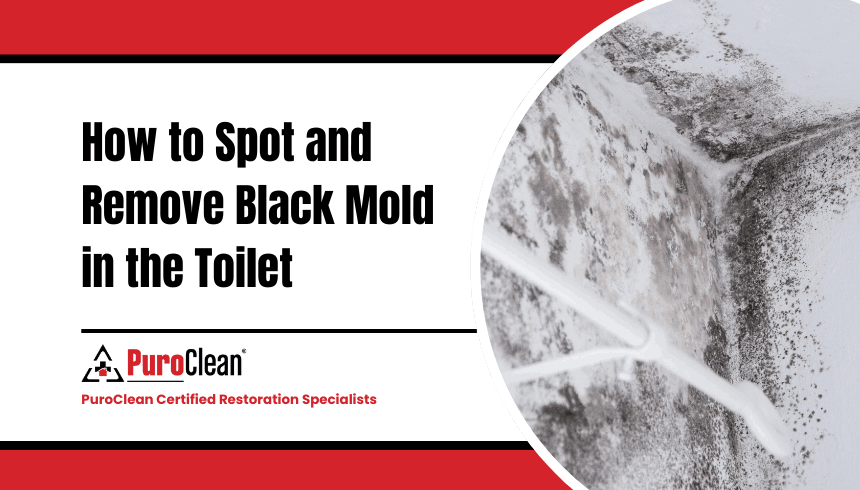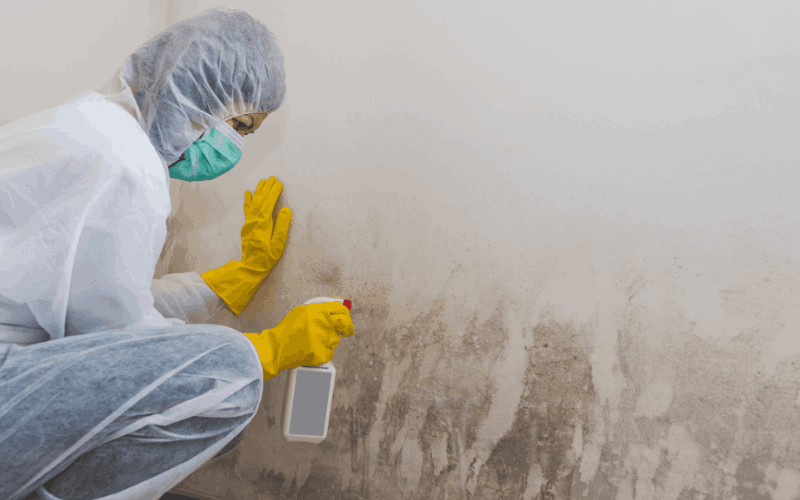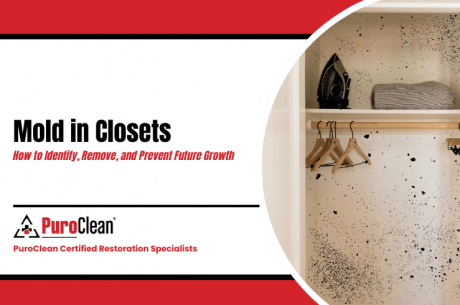
Key Takeaways
- The toilet is a common place for black mold because of constant moisture and humidity. It usually shows up as dark green or black patches around the toilet seals, grout, or base.
- Black mold can cause health problems like allergies, breathing issues, and eye irritation, especially for people with asthma or weak immune systems.
- Catching mold early helps prevent it from spreading. Keep an eye out for visible mold, a musty smell, or signs of water damage around your toilet.
- If the mold is widespread or hard to remove, it’s best to get professional help. Experts can ensure safe and thorough cleaning.
- Mold grows fast in bathrooms, so addressing moisture issues, cleaning regularly, and taking preventive steps will help you avoid bigger problems later on.
Black mold in the toilet is a common issue in many bathrooms, especially in areas where moisture levels are high. This type of mold can develop quickly if left unchecked, causing potential health risks and property damage. It thrives in warm, damp environments, which makes the toilet, with its constant exposure to water, a perfect breeding ground for mold growth.
Recognizing and addressing black mold early can prevent it from spreading to other areas of your bathroom. Although some homeowners may attempt to remove mold themselves, in cases of extensive growth, it’s important to consider mold removal services in Zephyrhills. In this blog, we’ll show you how to spot black mold in the toilet, how to safely remove it, and what you can do to keep it from coming back.
What Is Black Mold?
Black mold, or Stachybotrys chartarum, is a common type of mold that thrives in damp, humid areas, making bathrooms a perfect breeding ground. It’s usually dark green or black and can show up as fuzzy patches, slimy streaks, or wet spots on surfaces like wood, grout, or drywall.
Beyond being unsightly, black mold can affect your health. If you have a mold allergy, exposure to mold spores can trigger symptoms like sneezing, coughing, skin irritation, or watery eyes. That’s why it’s important to deal with black mold as soon as you notice it, before it spreads or worsens.
How to Spot Black Mold in the Toilet
Identifying black mold in the toilet early is key to preventing it from spreading. While mold can sometimes be hidden from view, there are a few telltale indications that can help you spot it before it becomes a bigger problem. Checking your toilet regularly and knowing what to look for will allow you to address the issue quickly and effectively.
• Visible Patches
The most obvious sign of black mold is the appearance of dark, discolored patches around the toilet. These patches are typically black or dark green and can appear on the toilet seals, base, or along the grout lines around the bathroom.
• Musty Odor
Another sign of black mold in the toilet is a musty smell, which is a clear indicator of mold growth. If you notice a persistent, unpleasant odor in your bathroom, it’s worth checking the toilet and surrounding areas for mold.
• Peeling Paint or Discoloration on the Toilet
Black mold can cause paint or caulk to peel or become discolored around the toilet. If you notice that the toilet seat, walls, or any painted surfaces are starting to peel, it may be due to mold growth beneath the surface.
• Leaks and Excess Moisture
Excess moisture is a common cause of mold growth. If there are leaks around your toilet, whether from the tank or base, it creates the perfect environment for mold to form. Check for any signs of water damage, such as water stains or puddles on the floor, which may also signal the presence of black mold.
How to Safely Remove Black Mold in the Toilet
Removing black mold in the toilet is important to maintain a safe and healthy bathroom environment. If left untreated, mold can spread quickly and potentially cause health issues. Here are some critical steps to safely remove black mold.
1. Assess the Situation
Before cleaning, take a moment to assess how much mold is present. If the mold is limited to small, visible patches, you may be able to address it with careful cleaning. However, if it covers a larger area or is hidden in hard-to-reach spaces, it is best to seek certified restoration experts for additional help.
2. Ventilate the Area
Open windows or use fans to improve airflow in the bathroom. Proper ventilation helps reduce exposure to mold spores and keeps the area safer while cleaning.
3. Clean Affected Areas
Carefully clean all areas with visible mold, including the toilet base, around seals, and under the tank. You can use cleaning solutions that are effective at breaking down mold. Be sure to follow safety guidelines when utilizing any cleaning product, and clean all surfaces thoroughly.
4. Disinfect to Prevent Recurrence
After cleaning, disinfect the surfaces to kill any remaining mold spores. Mold can return if moisture is left behind, so it’s essential to ensure thorough cleaning, especially in places that are prone to dampness.
5. Dry Thoroughly
Mold thrives in damp environments, so drying all affected areas is crucial. Wipe down the surfaces with a dry cloth and use a fan to speed up the drying process. Keeping the area dry will help avoid mold from coming back.

Tips to Prevent Black Mold Growth in the Toilet
Preventing black mold in the toilet is easier than dealing with it once it appears. By making a few simple changes and maintaining a dry, clean environment, you can significantly reduce the chances of mold growth. Here are some tips to help keep your toilet mold-free:
- Improve ventilation by using an exhaust fan or opening windows to reduce humidity.
- Fix any leaks around the toilet or plumbing right away to avoid excess moisture.
- Clean your toilet and bathroom surfaces regularly to remove mold spores before they can grow.
- Consider using mold-resistant caulking and grout to help prevent buildup.
- After using the toilet or shower, wipe down any surfaces prone to moisture.
- Use a dehumidifier if your bathroom stays damp to help reduce moisture in the air.
Frequently Asked Questions
Will black mold in the toilet spread to other parts of my house?
Yes, mold spores can travel through the air and spread to other areas of your home. It’s important to address the issue promptly to avoid a larger infestation.
Is black mold only found in bathrooms?
While black mold is common in bathrooms due to high humidity, it can grow anywhere in your home where there’s excess moisture. Common areas include kitchens, basements, and around leaky pipes or windows.
What should I do if I’ve tried cleaning black mold but it keeps coming back?
If mold keeps coming back after cleaning, it may indicate a deeper moisture issue or that the mold wasn’t fully removed. Consider having a professional mold inspection to find and fix any hidden sources of moisture that could be feeding the mold.
Conclusion
Black mold in the toilet is a common problem, but it can be managed with the right approach. Early detection, proper cleaning, and preventive steps can help stop mold from spreading. If the mold is persistent or starting to grow beyond the toilet, it’s important to act quickly to avoid health risks and potential damage. With regular inspections and consistent cleaning, you can keep your bathroom safe, healthy, and mold-free.
If you’re unsure how to handle the mold or need expert assistance, PuroClean Zephyrhills is just a call away. Our experienced team specializes in safe, effective mold removal to restore your bathroom and protect your home. Don’t wait—reach out to us today and let us help you create a cleaner, healthier, mold-free space!


